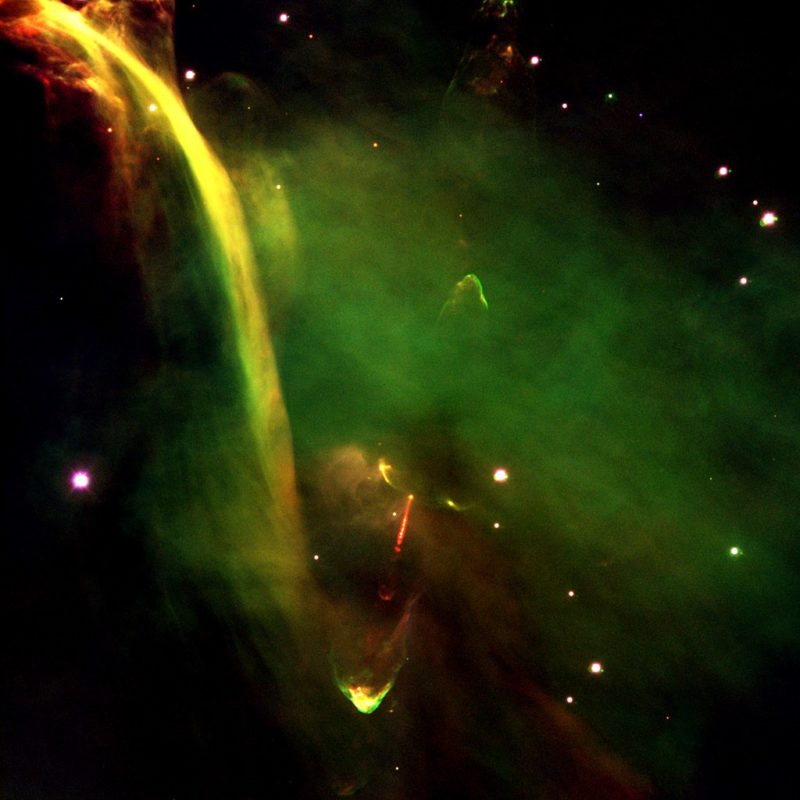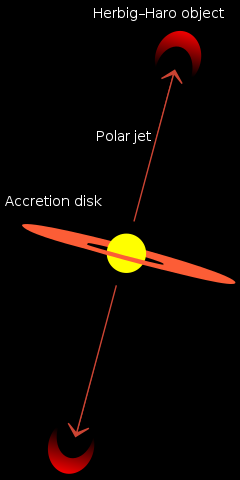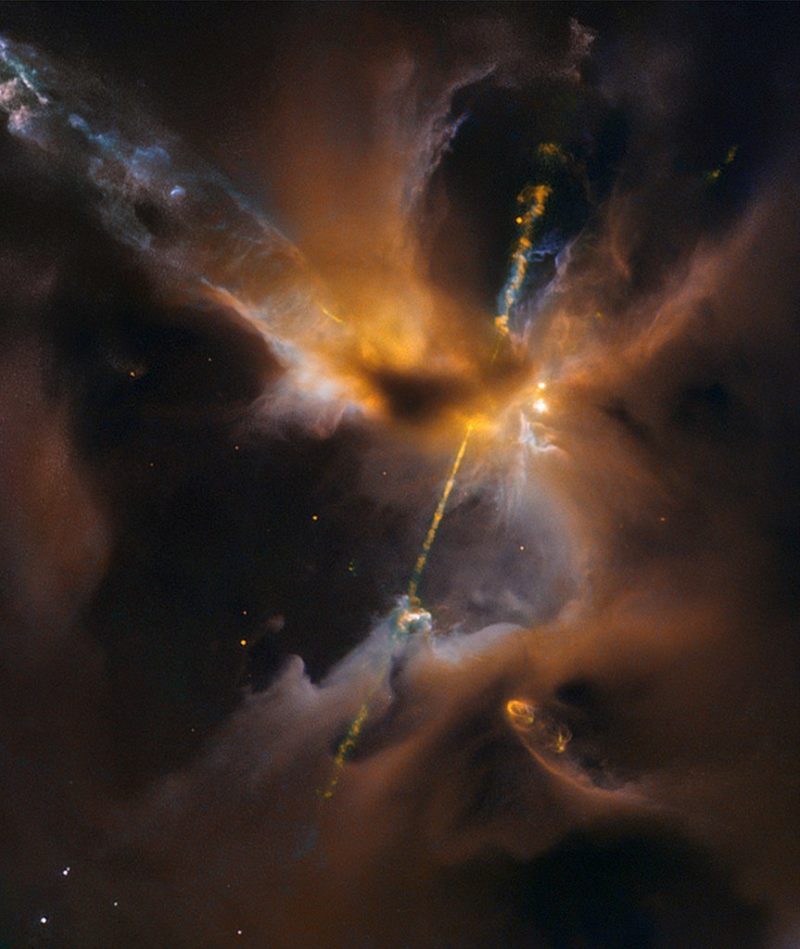
In the cosmic theater of starbirth, a celestial spectacle unfolds — the mysterious Herbig-Haro objects. Born from the intricate dance of newborn stars and luminous jets, these cosmic phenomena have intrigued astronomers for decades.
Join us on a journey through their discovery, characteristics, and the profound significance they hold in unraveling the secrets of stellar infancy. Welcome to the cosmic stage, where Herbig-Haro objects take center spotlight in the grand narrative of our celestial surroundings.
What Are Herbig-Haro Objects?
Herbig-Haro (HH) objects are celestial phenomena associated with the early stages of star formation. These objects manifest as bright patches of nebulosity, resulting from the interaction of high-speed gas jets ejected by young stars with the surrounding interstellar medium. The collisions create shockwaves, leading to the emission of distinct light patterns. They last around a few tens of thousands of years before dissipating. Studying Herbig-Haro objects provides valuable insights into the dynamic processes involved in the birth of stars.
Discovery and Historical Background
The first Herbig-Haro object was discovered in the late 19th century through the observations made by Sherburne Wesley Burnham while studying the star T Tauri. Initially perceived as an emission nebula, it took nearly fifty years for the significance of Burnham’s discovery to become apparent.
Around the 1940s, both George Herbig and Guillermo Haro independently observed several analogous nebulae within the Orion Nebula, noting their star-like appearances. These subsequent observations marked a crucial turning point in the understanding of Herbig-Haro objects, solidifying their recognition as distinct celestial phenomena associated with the early stages of star formation.
George Herbig, an American astronomer, and Guillermo Haro, a Mexican astronomer, brought attention to the dynamic nature of these objects, recognizing them as crucial markers of ongoing star formation. Their dedicated efforts in studying these celestial entities, characterized by shockwaves resulting from the interaction of high-speed jets with the interstellar medium, provided key insights into the intricate processes involved in the birth of stars.
Formation of Herbig-Haro Objects
Herbig-Haro (HH) objects originate from the intricate processes associated with the early stages of star formation. The formation of these celestial entities is intimately linked to the birth of young stars and the dynamic interactions occurring within their surrounding environments.
In the initial phases of star formation, a protostellar system develops, characterized by the presence of a protostar surrounded by an accretion disk. As material from the disk accretes onto the protostar, powerful jets of high-speed gas are ejected along the star’s rotation axis. These jets play a crucial role in the creation of Herbig-Haro objects.
When these energetic jets collide with the surrounding interstellar medium, shockwaves are generated. These shockwaves, in turn, lead to the ionization and excitation of the ambient gas, causing the emission of bright lines that characterize Herbig-Haro objects. The observed nebulosity represents the illuminated regions where these shockwaves interact with the surrounding material.


Properties and Characteristics of Herbig-Haro Objects
Herbig-Haro objects exhibit distinct properties and characteristics that make them recognizable in the vast cosmic landscape.
Emission Lines
Herbig-Haro objects are distinguished by the presence of bright emission lines in their spectra. These lines, observed primarily in the optical and near-infrared regions, signify the ionization and excitation of the surrounding gas. The specific wavelengths of these emission lines provide valuable information about the chemical composition and physical conditions within the shocked regions.
Bipolar Structures
The characteristic bipolar structures of Herbig-Haro objects manifest as elongated, symmetrical features along the axis defined by the protostar’s jets. This symmetry reflects the directional influence of the high-speed jets during the star formation process. The bipolar nature of these structures emphasizes the role of collimated outflows in shaping the surrounding interstellar medium.
Shockwave-Generated Nebulosity
Interaction between high-speed jets expelled from the protostar and the surrounding interstellar medium generates shockwaves. These shockwaves lead to the formation of nebulosities that become illuminated by the energetic processes associated with the collision. The resulting nebulosity serves as a visible marker, highlighting the dynamic and evolving nature of the star-forming environment.
Chemical Composition
Herbig-Haro objects provide a unique opportunity to probe the chemical composition of the material involved in the star-forming regions. The emission spectra of these objects reveal the presence of specific elements, such as hydrogen (75% of the total) and helium (24%). Analyzing the abundance and distribution of these elements contributes to our understanding of the elemental makeup of the interstellar material participating in the formation of stars.
Doppler Shift
The high velocities associated with the jets expelled from the protostar induce Doppler shifts in the spectral lines of Herbig-Haro objects. This phenomenon provides astronomers with crucial insights into the velocities of the ejected gas. Doppler-shifted lines in the spectra allow for the determination of the motion of the material within the shockwave-affected regions, contributing to our understanding of the dynamic nature of these stellar birth environments.
Protostellar Systems
Herbig-Haro objects serve as tangible markers for individual protostellar systems within star-forming regions. By identifying these objects, astronomers can study the early phases of star formation, gaining insights into the conditions surrounding young stars. The presence of Herbig-Haro objects is indicative of ongoing star-forming activity and provides a means to explore the characteristics of protostellar environments.
Multiwavelength Emission
Herbig-Haro objects emit radiation across a broad range of wavelengths, emphasizing the importance of multiwavelength observations. Utilizing optical and near-infrared observations, along with data from other parts of the electromagnetic spectrum, astronomers can construct a comprehensive view of these dynamic regions. Multiwavelength studies enable a detailed examination of the various physical processes occurring within Herbig-Haro objects, contributing to a more comprehensive understanding of their nature.
Loss of Mass
Herbig-Haro objects are associated with processes that involve the loss of mass from the protostar. As high-speed jets interact with the surrounding medium, material is expelled, contributing to the ongoing mass-loss dynamics in the star-forming region. This loss of mass is a very small amount of material compared to the total mass of the star but can amount to about 1-10% of the total mass accreted by the star in a year.
Distance from Star
The distance of Herbig-Haro objects from the central protostar is a critical parameter influencing their observational characteristics. Most of them are at about one parsec (3.26 light-years) from the star, although some have been observed several parsecs away. This distance provides insights into the spatial distribution of the shockwave-affected regions, offering astronomers valuable information about the extent of the star-forming environment.
Cosmic Signposts
Herbig-Haro objects act as cosmic signposts, marking regions of active star formation and dynamic interstellar processes. Their identification and study contribute significantly to our broader understanding of stellar birth. By serving as visible indicators of ongoing star-forming activity, Herbig-Haro objects play a crucial role in helping astronomers piece together the complex puzzle of the early stages of star formation and the associated interactions between young stars and their cosmic surroundings.


Numbers and Distribution
Understanding the distribution and prevalence of Herbig-Haro (HH) objects provides valuable insights into the broader context of star formation within different regions of the universe. Astronomers have identified over a thousand Herbig-Haro objects distributed across various star-forming regions, but there could be as many as 150,000 in the Milky Way to be discovered.
Herbig-Haro objects are often found within H II regions, stellar nurseries, near Bok globules, and other environments characterized by active star-forming activity. The distribution of Herbig-Haro objects within these regions provides astronomers with a statistical basis for studying the prevalence of protostellar systems and the associated outflow phenomena. The systematic observation and cataloging of Herbig-Haro objects contribute to our understanding of the overall demographics of young stars and their impact on the interstellar medium.
Significance of Herbig-Haro Studies
The study of Herbig-Haro (HH) objects holds profound significance in advancing our understanding of fundamental astrophysical processes related to star formation and the dynamic interplay between young stars and their cosmic surroundings.
Herbig-Haro objects serve as direct observational evidence of ongoing star formation. By identifying these objects within molecular clouds and other star-forming regions, astronomers can pinpoint regions of active stellar birth. This knowledge contributes to the broader understanding of the timescales and conditions involved in the formation of stars and planetary systems.
Furthermore, the investigation of Herbig-Haro objects provides critical insights into the mechanisms driving mass loss from young stars. The high-speed jets associated with these objects play a crucial role in shaping the surrounding interstellar medium, influencing the dynamics of the star-forming environment. Understanding mass loss processes is essential for comprehending the overall evolution of protostellar systems and their impact on the broader galactic context.
Herbig-Haro studies also contribute to our knowledge of shockwave physics and the effects of these shockwaves on the surrounding gas and dust. The emission lines observed in Herbig-Haro spectra enable astronomers to probe the physical conditions and chemical composition of the shocked material. This, in turn, enhances our understanding of the feedback mechanisms between young stars and their immediate environments.
Conclusion
In summary, Herbig-Haro objects stand as crucial cosmic signposts, marking regions of active star formation. From Sherburne Wesley Burnham’s initial observation in the late 19th century to the independent studies by George Herbig and Guillermo Haro in the mid-20th century, these objects have unraveled the complexities of stellar birth.
Their properties, such as bright emission lines and bipolar structures, offer unique insights into mass loss, shockwave physics, and the broader processes shaping the early stages of star formation. As beacons illuminating the cosmic stage, Herbig-Haro studies continue to enrich our understanding of the intricate dance between young stars and their cosmic environments.